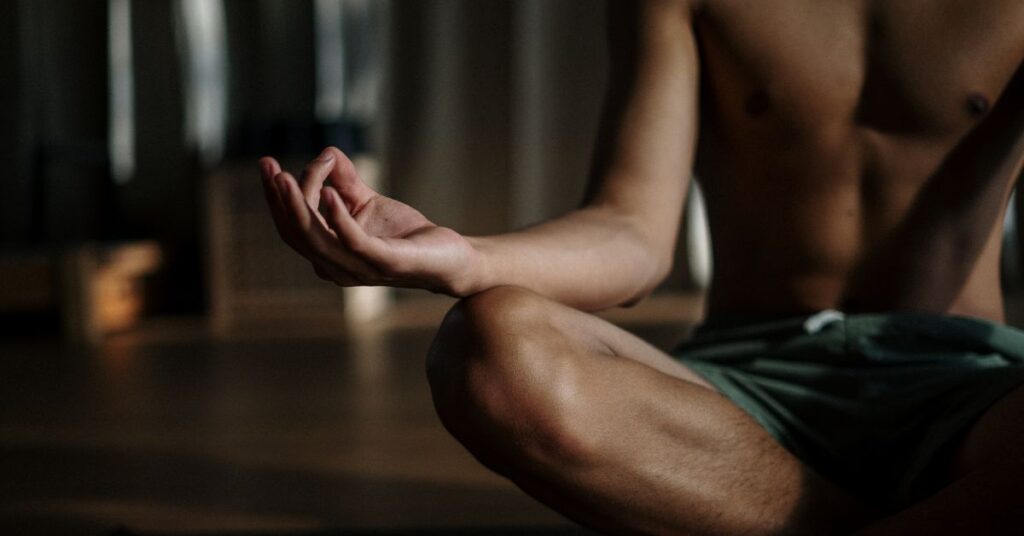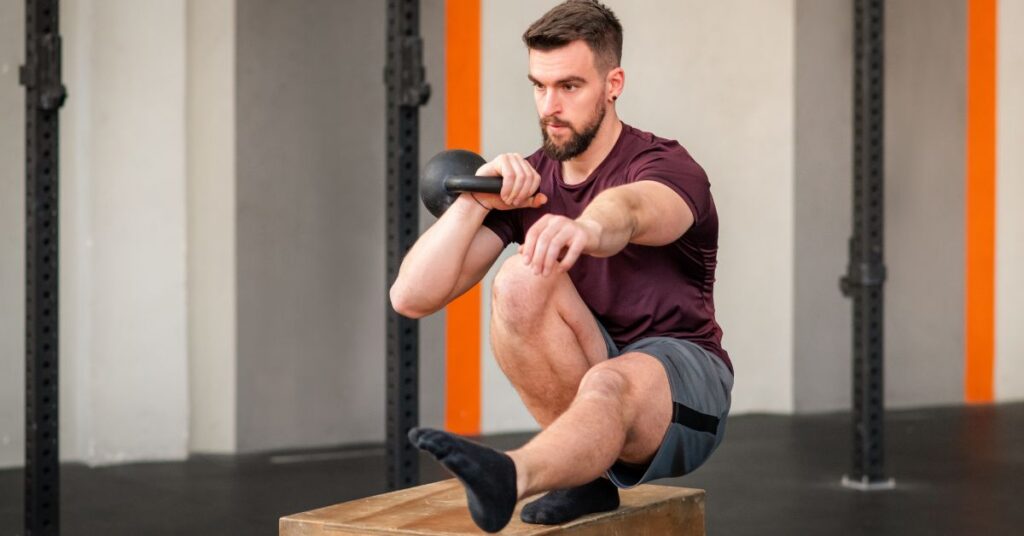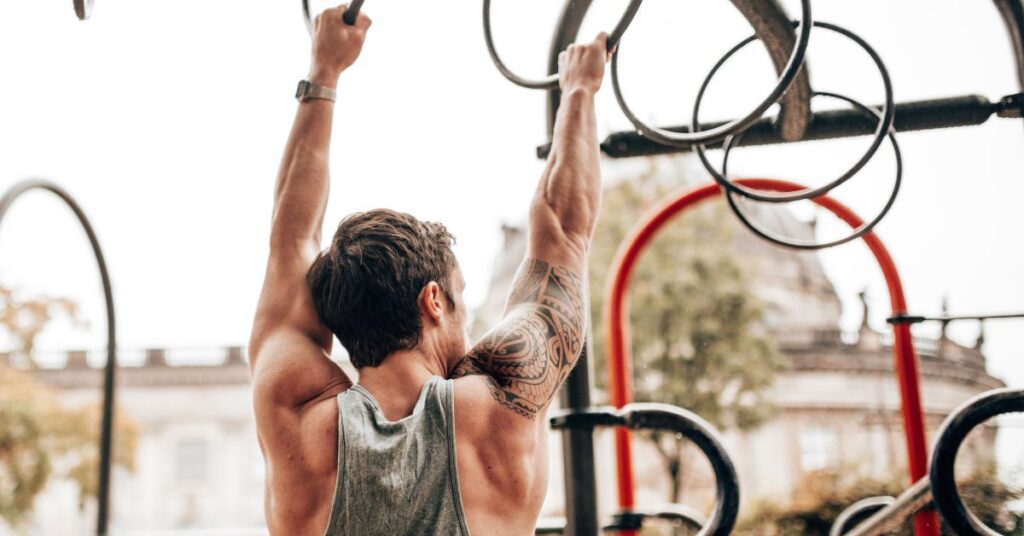20 Best Full Body Calisthenics Exercises are: Burpees for full body, Mountain Climbers for core, Bear Crawl for shoulders, Hindu Push-Up for upper body, Turkish Get-Up for coordination, Push-Up to T for chest, Pike Push-Up for shoulders, Crab Walk for posterior chain, Jump Squat for legs, and Plank to Downward Dog for flexibility and more.
In today’s fitness landscape, full body calisthenics workout have emerged as a powerful approach to building strength, improving flexibility, and achieving remarkable physical transformations. A good calisthenics workout for entire body not only targets multiple muscle groups but also enhances overall fitness levels. This comprehensive guide will walk you through everything you need to know about mastering bodyweight exercises and developing a strong, capable calisthenics body through exercises for body transformation. Discover the best calisthenics exercises that will help you on your journey to fitness excellence.
Table of Contents
20 Best Full Body Calisthenics Exercises
Full-body calisthenics workouts maximize efficiency by targeting multiple muscle groups simultaneously. These compound movements build functional strength, improve cardiovascular fitness, and enhance coordination. Perfect for time-conscious individuals, these exercises require no equipment while delivering comprehensive training that develops power, endurance, and mobility in a single session.
| Exercise | Primary Focus | Difficulty | Time | Reps/Duration |
|---|---|---|---|---|
| Burpees | Full Body + Cardio | Intermediate | 30-60 sec | 10-20 reps |
| Mountain Climbers | Core + Cardio | Beginner | 30-45 sec | 20-40 reps |
| Bear Crawl | Shoulders + Core | Intermediate | 30-60 sec | 10-20 steps |
| Hindu Push-Up | Upper Body + Flexibility | Advanced | 45 sec | 8-15 reps |
| Turkish Get-Up | Full Body Coordination | Advanced | 60 sec | 3-5 per side |
| Push-Up to T | Chest + Core + Balance | Intermediate | 45 sec | 8-12 reps |
| Pike Push-Up | Shoulders + Core | Intermediate | 45 sec | 8-15 reps |
| Crab Walk | Posterior Chain | Beginner | 30-45 sec | 10-20 steps |
| Jump Squat | Lower Body + Power | Beginner | 30-45 sec | 15-25 reps |
| Plank to Downward Dog | Core + Flexibility | Beginner | 45-60 sec | 10-15 reps |
| Single-Leg Deadlift | Balance + Posterior | Intermediate | 45 sec | 8-12 per leg |
| Jumping Lunges | Lower Body + Cardio | Intermediate | 30-45 sec | 16-24 reps |
| Spider Push-Up | Core + Upper Body | Advanced | 45 sec | 8-14 reps |
| Squat Thrust | Full Body + Power | Intermediate | 30-45 sec | 12-18 reps |
| Reverse Lunge with Knee Drive | Lower Body + Balance | Beginner | 45 sec | 10-16 per leg |
| Plank Jacks | Core + Cardio | Beginner | 30-45 sec | 20-30 reps |
| Inchworm | Full Body + Flexibility | Beginner | 45 sec | 6-10 reps |
| Side Plank with Reach | Core + Stability | Intermediate | 45 sec | 8-12 per side |
| Commando Crawl | Full Body + Core | Advanced | 45-60 sec | 8-15 steps |
| Frog Jump | Lower Body + Power | Beginner | 30-45 sec | 12-20 reps |
These resistance band workouts for men are perfect for strength, flexibility, and full-body conditioning—anytime, anywhere. Find out the truth behind does jumping jacks reduce belly fat and how to use them effectively for fat loss.
20 Full Body Calisthenics Exercises in Detail
1. Burpees
Burpees represent the pinnacle of full-body conditioning, combining cardiovascular endurance with strength training in one explosive movement. This compound exercise engages every major muscle group while dramatically elevating heart rate, making it incredibly efficient for time-pressed individuals. Originally developed for military fitness testing, burpees build functional strength, improve coordination, and develop mental resilience through their challenging nature.
How to do Burpees?
- Start standing with feet hip-width apart, arms at sides
- Squat down and place hands on floor in front of feet
- Jump or step feet back into plank position
- Perform one push-up (optional for beginners)
- Jump or step feet back toward hands
- Explode up into a jump with arms overhead
- Land softly and immediately begin next repetition
- Maintain steady breathing rhythm throughout movement
2. Mountain Climbers
Mountain climbers offer an exceptional core-strengthening workout while simultaneously providing cardiovascular benefits. This dynamic exercise mimics the motion of climbing while maintaining a plank position, creating intense activation of the deep core muscles. The rapid alternating leg movement challenges coordination and agility while building endurance. Mountain climbers are perfect for developing functional core strength that translates to improved performance in daily activities and other exercises.
How to do Mountain Climbers?
- Begin in high plank position with hands directly under shoulders
- Keep body in straight line from head to heels
- Bring right knee toward chest while keeping left leg extended
- Quickly switch legs, bringing left knee to chest
- Continue alternating legs in running motion
- Maintain plank position throughout exercise
- Keep hips level and avoid bouncing up and down
- Breathe steadily while maintaining rapid leg movement
3. Bear Crawl
Bear crawls tap into primal movement patterns that our bodies naturally understand, making them incredibly effective for developing functional strength. This exercise challenges the entire kinetic chain while requiring significant coordination and stability. The quadruped position engages the core intensely while building shoulder stability and strength. Bear crawls improve proprioception and body awareness while creating a strong foundation for more complex movements. They’re excellent for developing the type of strength needed for real-world activities.
How to do Bear Crawl?
- Start on hands and knees with wrists under shoulders
- Lift knees 2-3 inches off ground, balancing on hands and toes
- Keep back flat and core engaged throughout movement
- Move forward by stepping opposite hand and foot simultaneously
- Take small, controlled steps maintaining low position
- Keep knees close to ground without touching
- Maintain steady breathing and smooth movement pattern
- Can be performed forward, backward, or side-to-side
4. Hindu Push-Up
Hindu push-ups represent a beautiful fusion of strength training and flexibility work, originating from ancient Indian wrestling traditions. This flowing movement creates a wave-like motion through the spine while building upper body strength and enhancing flexibility. The exercise improves spinal mobility and shoulder flexibility while providing a comprehensive upper body workout. Hindu push-ups develop fluid movement patterns that enhance overall body coordination and create a mind-body connection through their rhythmic, meditative nature.
How to do Hindu Push-Up?
- Begin in downward dog position with hands shoulder-width apart
- Keep hips high and legs straight, forming inverted V-shape
- Lower chest toward floor while shifting weight forward
- Swoop chest between hands and lift into upward dog position
- Push hips back and up, returning to downward dog position
- Create smooth, flowing movement throughout entire sequence
- Keep core engaged and maintain controlled breathing
- Focus on quality of movement over speed or quantity
5. Turkish Get-Up
The Turkish get-up stands as one of the most complex and beneficial full-body exercises in existence. This ancient movement pattern requires the coordination of strength, mobility, and stability while transitioning from lying down to standing. Every muscle in the body must work together harmoniously, making it exceptional for developing functional strength and body awareness. The Turkish get-up challenges proprioception and creates resilient movement patterns that translate directly to improved quality of life and injury prevention.
How to do Turkish Get-Up?
- Lie on back with right arm extended toward ceiling
- Bend right knee and place right foot flat on floor
- Roll onto left elbow, then press up to left hand
- Lift hips and sweep left leg under body into kneeling position
- Stand up while keeping right arm extended overhead
- Reverse the movement to return to starting position
- Perform all repetitions on one side before switching
- Move slowly and maintain control throughout entire sequence
6. Push-Up to T
The push-up to T combines traditional upper body strengthening with rotational movement and balance challenges. This exercise develops unilateral strength while improving core stability and shoulder mobility. The rotational component enhances functional strength patterns used in many daily activities and sports. By adding the T-rotation, this exercise becomes a comprehensive movement that builds strength, stability, and coordination simultaneously, making it incredibly efficient for full-body conditioning.
How to do Push-Up to T?
- Start in high plank position with hands shoulder-width apart
- Perform one standard push-up with proper form
- At the top of push-up, shift weight to left hand
- Rotate body right, lifting right arm toward ceiling
- Form T-shape with arms and hold briefly
- Return to plank position with control
- Perform another push-up, then rotate to opposite side
- Alternate sides with each repetition or complete sets on one side
7. Pike Push-Up
Pike push-ups serve as an excellent progression toward handstand push-ups while building significant shoulder and tricep strength. This inverted position challenges the shoulders in a vertical pressing pattern, which is often neglected in traditional training. The exercise improves shoulder flexibility and stability while engaging the core for balance and control. Pike push-ups develop the specific strength patterns needed for advanced calisthenics movements while being accessible to intermediate practitioners.
How to do Pike Push-Up?
- Start in downward dog position with hands shoulder-width apart
- Walk feet closer to hands to create steeper pike angle
- Keep legs straight and weight distributed on hands and feet
- Lower head toward floor by bending elbows
- Press back up to starting position
- Keep core engaged throughout movement
- Maintain pike position without letting hips drop
- Focus on controlled movement rather than speed
8. Crab Walk
Crab walks target the often-neglected posterior chain muscles while improving overall coordination and mobility. This exercise strengthens the glutes, hamstrings, and shoulders while challenging the body to move in an unfamiliar pattern. The reverse tabletop position improves hip mobility and strengthens the muscles responsible for good posture. Crab walks develop balanced muscle development by working the backside of the body, which is crucial for preventing imbalances caused by modern sedentary lifestyles.
How to do Crab Walk?
- Sit with knees bent and hands behind body, fingers pointing toward feet
- Lift hips up into reverse tabletop position
- Keep chest open and head in neutral position
- Walk forward by moving opposite hand and foot simultaneously
- Take small, controlled steps while maintaining hip height
- Keep shoulders directly over wrists
- Engage glutes and hamstrings throughout movement
- Can be performed forward, backward, or side-to-side
9. Jump Squat
Jump squats represent the perfect marriage of strength and power development for the lower body. This explosive movement builds functional strength while improving athletic performance through plyometric training. The combination of squatting and jumping develops the fast-twitch muscle fibers responsible for power and explosiveness. Jump squats enhance vertical jumping ability while providing cardiovascular benefits, making them ideal for athletes and fitness enthusiasts seeking to improve their overall conditioning and performance.
How to do Jump Squat?
- Stand with feet hip-width apart, toes slightly turned out
- Lower into squat position with thighs parallel to floor
- Keep chest up and weight evenly distributed on feet
- Explode up into jump, extending hips and knees fully
- Land softly on balls of feet, immediately lowering into next squat
- Keep knees aligned over toes during landing
- Use arms for momentum and balance
- Focus on soft landings to protect joints
10. Plank to Downward Dog
This dynamic movement combines the static strength benefits of planks with the flexibility and mobility benefits of downward dog. The transition between these two positions creates a flowing movement that strengthens the core while stretching the posterior chain. This exercise improves spinal mobility and shoulder flexibility while building functional movement patterns. The combination of strength and flexibility work makes this exercise perfect for improving overall movement quality and preparing the body for more complex exercises.
How to do Plank to Downward Dog?
- Begin in high plank position with straight line from head to heels
- Keep hands firmly planted and core engaged
- Push hips up and back, straightening legs
- Form inverted V-shape in downward dog position
- Hold briefly, feeling stretch in hamstrings and calves
- Lower hips back to plank position with control
- Maintain straight line in plank without sagging hips
- Continue transitioning smoothly between positions
11. Single-Leg Deadlift
Single-leg deadlifts challenge balance, proprioception, and unilateral strength while targeting the posterior chain muscles. This exercise exposes and corrects imbalances between left and right sides of the body while improving hip stability and mobility. The single-leg stance forces deep core activation and challenges the stabilizing muscles throughout the leg and hip. This functional movement pattern directly translates to improved performance in daily activities and sports while helping prevent injuries through better balance and stability.
How to do Single-Leg Deadlift?
- Stand on left leg with slight bend in knee
- Extend right leg behind body while hinging at hip
- Lower torso toward floor while lifting right leg
- Reach toward floor with fingertips for balance
- Keep back straight and core engaged throughout
- Drive through left heel to return to starting position
- Focus on controlled movement rather than range of motion
- Complete all reps on one leg before switching sides
12. Jumping Lunges
Jumping lunges add an explosive plyometric element to traditional lunges, creating a high-intensity exercise that builds power and cardiovascular fitness. This exercise develops unilateral leg strength while improving coordination and agility. The jumping component enhances athletic performance by training the stretch-shortening cycle of muscles. Jumping lunges challenge balance and stability while providing an excellent cardiovascular workout, making them perfect for high-intensity interval training and sports-specific conditioning.
How to do Jumping Lunges?
- Start in lunge position with right foot forward
- Lower into deep lunge with both knees at 90 degrees
- Explode up into jump, switching leg positions mid-air
- Land softly with left foot forward in lunge position
- Immediately lower into next lunge and prepare to jump
- Keep torso upright and core engaged throughout
- Use arms for balance and momentum
- Focus on soft landings and controlled movement
13. Spider Push-Up
Spider push-ups combine the upper body strengthening benefits of push-ups with dynamic hip mobility and core activation. This exercise challenges the core through anti-rotation while improving hip flexibility and upper body strength. The knee-to-elbow movement enhances coordination and adds a cardiovascular component to the traditional push-up. Spider push-ups develop functional strength patterns while improving mobility, making them excellent for athletes and anyone seeking comprehensive conditioning.
How to do Spider Push-Up?
- Begin in high plank position with hands shoulder-width apart
- As you lower into push-up, bring right knee toward right elbow
- Keep knee close to ground as it moves toward elbow
- Push back up while returning leg to starting position
- Alternate legs with each push-up repetition
- Keep core tight to prevent hip sagging
- Maintain controlled movement throughout exercise
- Focus on coordination between upper and lower body
14. Squat Thrust
Squat thrusts provide an intense full-body workout that combines strength training with cardiovascular conditioning. This exercise builds explosive power while improving coordination and agility. The rapid transition between squatting and jumping back creates significant metabolic demand while strengthening multiple muscle groups. Squat thrusts are excellent for developing the type of power and conditioning needed for sports and high-intensity activities while being adaptable to various fitness levels.
How to do Squat Thrust?
- Stand with feet hip-width apart, arms at sides
- Squat down and place hands firmly on floor
- Jump feet back into plank position quickly
- Keep body in straight line from head to heels
- Jump feet back toward hands in squat position
- Return to standing position without jumping up
- Maintain fast pace while keeping proper form
- Focus on smooth transitions between positions
15. Reverse Lunge with Knee Drive
This dynamic exercise combines the strength-building benefits of reverse lunges with the power and coordination challenges of knee drives. The movement pattern improves unilateral strength while enhancing balance and proprioception. The knee drive component adds a cardiovascular element while training explosive hip flexion. This exercise develops functional strength patterns used in walking, running, and climbing while improving overall athletic performance and movement quality.
How to do Reverse Lunge with Knee Drive?
- Stand with feet hip-width apart, hands at sides
- Step right foot back into reverse lunge position
- Lower until both knees are at 90-degree angles
- Push through left heel to drive back up
- Drive right knee up toward chest explosively
- Balance briefly on left leg with knee raised
- Return right foot to starting position
- Complete all reps on one side before switching
16. Plank Jacks
Plank jacks combine the core-strengthening benefits of planks with the cardiovascular challenge of jumping jacks. This exercise maintains the plank position while adding dynamic leg movement, creating intense core activation and cardiovascular demand. The combination of static upper body hold with dynamic lower body movement challenges stability and coordination. Plank jacks are perfect for high-intensity interval training while building functional core strength and endurance.
How to do Plank Jacks?
- Begin in high plank position with feet together
- Keep hands firmly planted and core engaged
- Jump feet apart while maintaining plank position
- Jump feet back together to starting position
- Keep hips level throughout jumping movement
- Maintain straight line from head to heels
- Continue jumping feet in and out rhythmically
- Focus on keeping upper body stable during leg movement
17. Inchworm
Inchworms provide a comprehensive full-body stretch and strengthening exercise that improves flexibility while building functional strength. This movement enhances spinal mobility and hamstring flexibility while strengthening the shoulders and core. The slow, controlled movement pattern improves body awareness and coordination while providing a gentle cardiovascular challenge. Inchworms are excellent for warming up, improving mobility, and building the foundation for more advanced movements.
How to do Inchworm?
- Stand with feet hip-width apart, arms at sides
- Hinge at hips and place hands on floor in front of feet
- Walk hands forward into plank position
- Keep legs straight throughout walking motion
- Hold plank position briefly with proper alignment
- Walk hands back toward feet, keeping legs straight
- Return to standing position with controlled movement
- Focus on smooth, flowing movement throughout exercise
18. Side Plank with Reach
Side planks with reach combine lateral core strengthening with dynamic movement and coordination challenges. This exercise targets the often-neglected lateral stabilizers while improving shoulder mobility and rotational strength. The reaching component adds instability, forcing deeper core activation and improved proprioception. This movement develops functional strength for daily activities involving rotation and reaching while building comprehensive core stability and control.
How to do Side Plank with Reach?
- Begin in side plank position on left elbow and feet
- Keep body in straight line from head to feet
- Extend right arm toward ceiling for balance
- Reach right arm under body and behind left side
- Return arm to starting position with control
- Keep hips elevated and core engaged throughout
- Maintain side plank position during reaching movement
- Complete all reps on one side before switching
19. Commando Crawl
Commando crawls represent an advanced full-body exercise that combines core strength, coordination, and endurance. This military-inspired movement challenges every muscle group while requiring precise coordination between upper and lower body. The low crawling position creates intense core activation while building functional strength patterns. Commando crawls develop the type of total-body conditioning and mental toughness needed for high-performance activities while improving movement quality and body awareness.
How to do Commando Crawl?
- Begin in plank position with forearms on ground
- Keep body low and parallel to floor throughout
- Move forward by crawling on forearms and toes
- Coordinate opposite arm and leg movements
- Keep hips low and core engaged during movement
- Move in straight line with controlled pace
- Maintain steady breathing despite challenging position
- Can be performed forward, backward, or side-to-side
20. Frog Jump
Frog jumps provide an explosive lower body workout that builds power and cardiovascular fitness through plyometric training. This exercise mimics the natural jumping pattern of frogs, creating a fun yet challenging movement that develops leg strength and power. The deep squat position improves hip and ankle mobility while the jumping component enhances athletic performance. Frog jumps are excellent for developing explosive power and functional strength while providing an intense cardiovascular workout.
How to do Frog Jump?
- Can be performed in place or moving forward
- Start in deep squat position with hands on floor between legs
- Keep chest up and weight evenly distributed
- Explode forward and upward, extending hips and knees
- Land softly in deep squat position, hands touching ground
- Immediately prepare for next jump without standing up
- Keep core engaged and maintain low center of gravity
- Focus on soft landings and controlled movement
Explore these effective resistance band workouts for women designed for all fitness levels.
What is a Full Body Calisthenics Workout?
A full body calisthenics workout is a training method that uses different best calisthenics exercises to develop strength, flexibility, and overall fitness. Unlike traditional weight training, a good calisthenics workout relies on natural movements that engage multiple muscle groups simultaneously, promoting functional strength and improved body awareness.
Learn which exercise reduce back fat and try these back exercises with dumbbells for a stronger upper body.
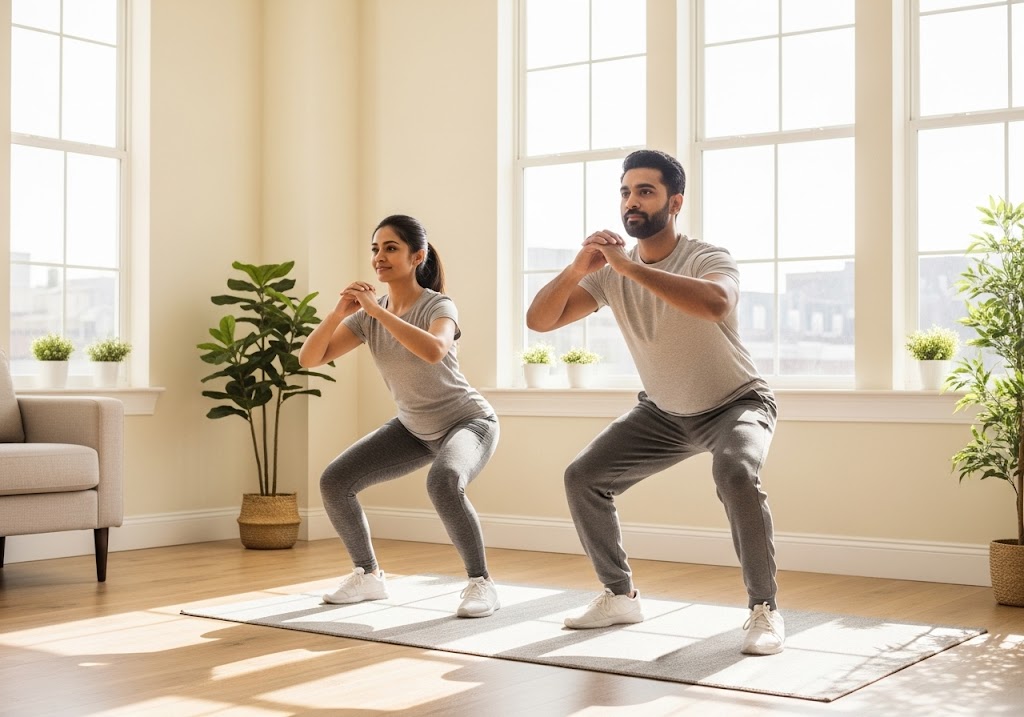
10 Easiest Full Body Calisthenics Workout
Perfect for absolute beginners, these gentle full-body movements activate multiple muscle groups while building foundational strength and coordination. Each exercise can be modified further and requires no equipment, making them accessible for all fitness levels and ideal for establishing consistent workout habits.
| Exercise | Primary Benefits | Description | Beginner Modifications |
|---|---|---|---|
| Marching in Place with Arm Circles | Cardio, Coordination, Shoulders | March lifting knees while rotating arms in circles | Smaller arm circles, lower knee lifts |
| Wall Push-Ups with Calf Raises | Chest, Shoulders, Calves | Push against wall, then rise onto toes between reps | Stand closer to wall, skip calf raises initially |
| Chair Step-Ups | Legs, Core, Balance | Step up onto stable chair/platform alternating legs | Use lower step, hold handrail for support |
| Squat with Arm Raises | Legs, Shoulders, Core | Shallow squat while raising arms overhead | Partial squat depth, keep arms at shoulder height |
| Standing Side Bends with Leg Lifts | Core, Obliques, Hip Flexors | Bend to side while lifting opposite leg out | Smaller range of motion, hold wall for balance |
| Modified Inchworms | Full Body, Core, Flexibility | Walk hands forward from standing, then back | Walk hands out only halfway, bend knees if needed |
| Forward Lunges with Arm Swings | Legs, Core, Shoulders | Step forward into lunge with opposite arm swing | Smaller lunge steps, gentle arm movements |
| Seated to Standing | Legs, Core, Functional | Sit and stand from chair without using hands | Use hands on thighs for assistance initially |
| Standing Hip Circles with Arm Waves | Hips, Core, Shoulders | Circle hips while moving arms in wave motions | Smaller circles, simpler arm movements |
| Heel-Toe Walking with Arm Pumps | Balance, Core, Coordination | Walk placing heel in front of toe with arm pumps | Normal walking pace, hold wall if needed |
Wondering if skipping helps shed fat? Here’s the answer – can skipping help lose weight.
1. Marching in Place with Arm Circles
Stand with feet hip-width apart and begin marching by lifting one knee to hip height, then alternate legs in a steady rhythm. Simultaneously, extend your arms out to the sides and create small to medium circles, rotating forward for 30 seconds, then backward. This exercise activates your cardiovascular system while warming up shoulder joints and improving coordination between upper and lower body movements.
2. Wall Push-Ups with Calf Raises
Position yourself arm’s length from a wall, place palms flat against the wall at shoulder height and width. Perform a controlled push-up by leaning toward the wall and pushing back. After each push-up, rise onto your toes for a calf raise, then lower back down. This combination targets chest, shoulders, and calves while being much easier than floor push-ups.
3. Chair Step-Ups
Using a sturdy chair or step platform, place your right foot completely on the seat, ensuring your heel is secure. Step up by pushing through your right leg, bringing your left foot up to meet it, then step back down with control. Alternate leading legs every 10 reps. This exercise builds lower body strength and improves balance and coordination.
4. Squat with Arm Raises
Stand with feet slightly wider than hip-width, toes pointing slightly outward. Lower into a shallow squat by bending your knees and pushing your hips back, while simultaneously raising both arms straight up overhead. Return to standing while lowering arms to your sides. Focus on keeping your chest up and weight in your heels throughout the movement.
5. Standing Side Bends with Leg Lifts
Stand tall with hands on hips or crossed over chest. Gently bend your torso to the right while simultaneously lifting your left leg out to the side. Return to center and repeat on the opposite side, bending left while lifting your right leg. This exercise targets your obliques, improves lateral stability, and enhances hip mobility.
6. Modified Inchworms
Start standing with feet hip-width apart. Bend forward at the waist and place your hands on the ground (bend knees if needed). Walk your hands forward until you reach a comfortable plank-like position, then walk your hands back toward your feet and return to standing. This full-body movement improves flexibility while strengthening core and shoulders.
7. Forward Lunges with Arm Swings
Step your right foot forward into a shallow lunge, lowering your back knee slightly toward the ground. As you lunge, swing your left arm forward and right arm back. Push off your front foot to return to starting position and repeat on the opposite side. This exercise develops leg strength, balance, and coordination between opposite limbs.
8. Seated to Standing
Sit in a sturdy chair with feet flat on the floor, hip-width apart. Without using your hands for assistance, lean slightly forward and stand up by pushing through your heels and engaging your leg muscles. Slowly lower back down to the seated position with control. This functional exercise strengthens legs and core while improving daily movement patterns.
9. Standing Hip Circles with Arm Waves
Stand with feet hip-width apart, hands at your sides. Make slow, controlled circles with your hips, moving clockwise for 10 rotations, then counterclockwise for 10. While circling your hips, create gentle wave-like motions with your arms, moving them up and down in a flowing pattern. This exercise improves hip mobility and adds gentle upper body movement.
10. Heel-Toe Walking with Arm Pumps
Walk in a straight line by placing the heel of one foot directly in front of the toes of the other foot, as if walking on a tightrope. Take slow, deliberate steps while pumping your arms in opposition (left arm forward when right foot steps). This exercise challenges your balance, improves coordination, and strengthens stabilizing muscles throughout your core and legs.
arn exactly how many calories 500 skipping burns and how to make your jump sessions count.
All Calisthenics Exercises For Full Body Calisthenics Workout
Calisthenics offers a complete fitness solution using only bodyweight resistance. These exercises build strength, endurance, and flexibility while requiring minimal equipment. From beginner-friendly movements to advanced skills, calisthenics provides progressive training for every fitness level, targeting all major muscle groups through compound movements that enhance functional strength and body control.
| Category | Exercise | Primary Muscles | Difficulty |
| UPPER BODY – PUSH | |||
| Push-Up | Chest, Triceps, Shoulders | Beginner | |
| Incline Push-Up | Chest, Triceps, Shoulders | Beginner | |
| Diamond Push-Up | Triceps, Chest | Intermediate | |
| Pike Push-Up | Shoulders, Triceps | Intermediate | |
| One-Arm Push-Up | Chest, Triceps, Core | Advanced | |
| DIPS & TRICEPS | |||
| Chair Tricep Dip | Triceps, Chest | Beginner | |
| Tricep Dip On Bench | Triceps, Chest | Intermediate | |
| Side Lying Tricep Press | Triceps | Beginner | |
| Wall Tricep Press | Triceps | Beginner | |
| Chair Chest Dip | Chest, Triceps | Beginner | |
| UPPER BODY – PULL | |||
| Chin-Up | Biceps, Lats, Rhomboids | Intermediate | |
| Wide-Grip Pull-Up | Lats, Rhomboids, Rear Delts | Intermediate | |
| Chair Inverted Row | Lats, Rhomboids, Rear Delts | Beginner | |
| Close-Grip Chin-Up | Biceps, Lats | Intermediate | |
| Bodyweight Bicep Curl | Biceps | Beginner | |
| CORE & ABS | |||
| Plank | Core, Shoulders | Beginner | |
| Side Plank | Obliques, Core | Beginner | |
| Crunch | Abs | Beginner | |
| Russian Twist | Obliques, Core | Intermediate | |
| Mountain Climber | Core, Cardio, Hip Flexors | Intermediate | |
| LOWER BODY | |||
| Jump Squat | Quads, Glutes, Power | Intermediate | |
| Glute Bridge | Glutes, Hamstrings | Beginner | |
| Split Squat | Quads, Glutes | Intermediate | |
| Single-Leg Glute Bridge | Glutes, Hamstrings, Stability | Intermediate | |
| Cossack Squat | Adductors, Quads, Mobility | Intermediate | |
| FULL BODY & CARDIO | |||
| Burpees | Full Body, Cardio | Intermediate | |
| Bear Crawl | Full Body, Core | Intermediate | |
| High Knees | Hip Flexors, Cardio | Beginner | |
| Butt Kickers | Hamstrings, Cardio | Beginner | |
| Crab Walk | Shoulders, Glutes, Core | Intermediate | |
| STRETCHES & MOBILITY | |||
| Cross-Body Shoulder Stretch | Shoulders, Flexibility | All Levels | |
| Seated Hamstring Stretch | Hamstrings, Flexibility | All Levels | |
| Overhead Triceps Stretch | Triceps, Flexibility | All Levels | |
| Doorway Chest Stretch | Chest, Shoulders | All Levels | |
| Child’s Pose | Back, Hips, Relaxation | All Levels | |
| WRIST & FOREARM | |||
| Wrist Extension | Wrist Extensors | All Levels | |
| Wrist Adduction | Wrist Adductors | All Levels | |
| Bodyweight Reverse Wrist Curl | Wrist Extensors | All Levels | |
| Bodyweight Inner Wrist Curl | Wrist Flexors | All Levels | |
| Finger Down Forearm Stretch | Forearms, Wrists | All Levels |
Try this effective resistance band workout for triceps to isolate and grow your triceps anywhere, anytime.
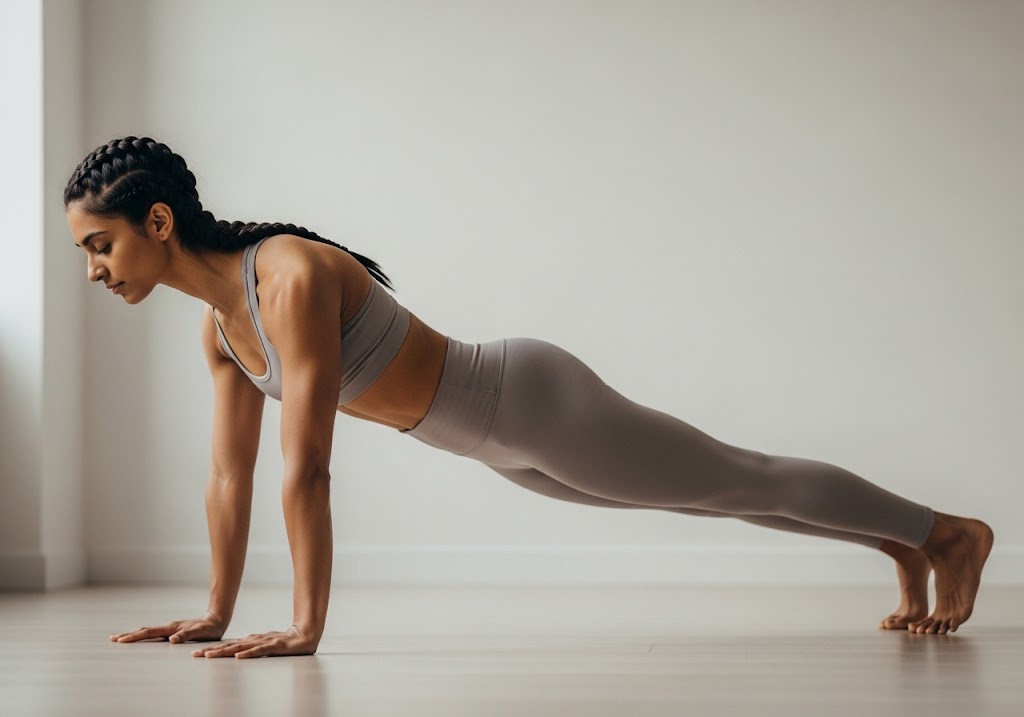
Benefits of a Full Body Calisthenics Routine for Strength and Flexibility
A full body calisthenics workout develops strength and flexibility by focusing on natural, bodyweight movements that engage multiple muscle groups at once. These exercises mirror everyday motions, making them especially effective for improving functional strength and body control. Over time, they enhance coordination, increase lean muscle mass, and support joint mobility—without the need for heavy weights or machines. This style of training is accessible, adaptable, and ideal for long-term physical health.
Key Benefits at a Glance:
- Encourages functional, real-world strength
- Enhances coordination and spatial awareness
- Promotes lean muscle growth across all major muscle groups
- Maintains joint flexibility and mobility
- Requires little to no equipment, making it travel- and home-friendly
- Supports injury prevention through controlled, progressive movement
Learn how to train and perfect your calisthenics handstand – whether you’re a beginner or levelling up.
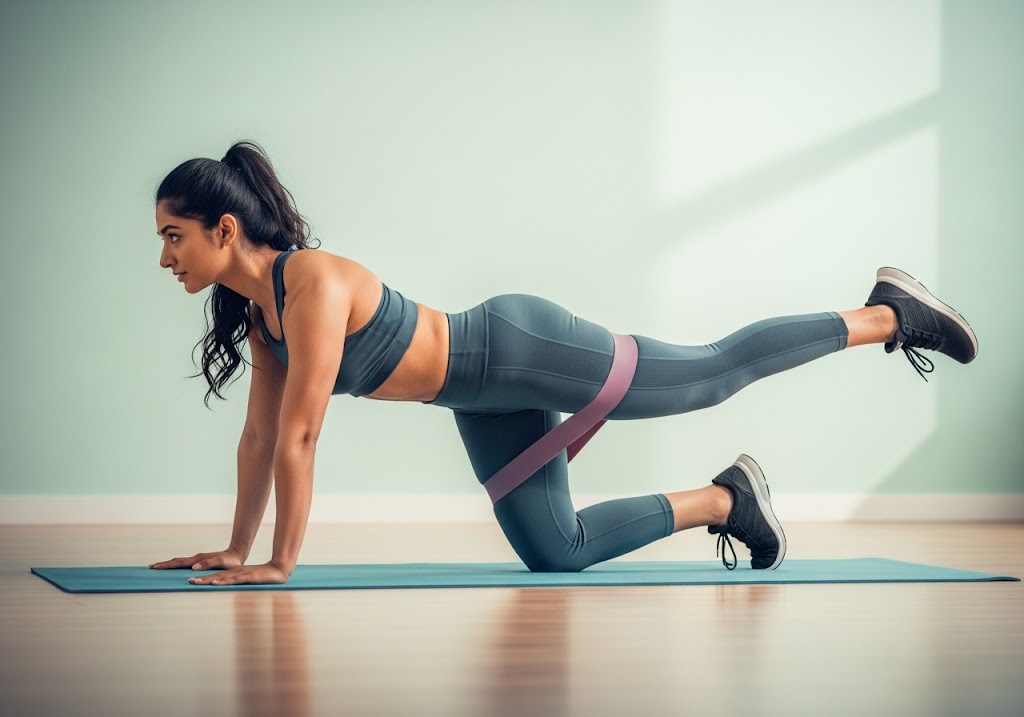
Key Components of a Full Body Calisthenics Workout
A complete full-body calisthenics workout requires strategic planning and proper structure. Essential components include dynamic warm-up, compound movements targeting all muscle groups, progressive overload principles, adequate rest periods, and cool-down stretches. Understanding these fundamentals ensures maximum effectiveness, injury prevention, and sustainable progress in your bodyweight training journey.
Warm-Up Essentials
- Light cardio preparation as part of transformation exercises through jumping jacks or jogging primes your calisthenics body for an effective full body calisthenics workout. This increases blood flow and raises core temperature, preparing muscles for more intense work.
- Dynamic stretching routines as calisthenics exercise should target the specific muscle groups you’ll use in your calisthenics body training. Focus on shoulder circles, hip openers, and ankle mobility to prepare for complex movements.
- Movement practice with lighter variations helps perfect form before intense training. Practicing easier progressions of transformation exercises ensures proper technique during the main workout.
Core Stability Foundation
- Plank variations is a good calisthenics workout in calisthenics training to build essential core strength through isometric holds. Side planks and reverse planks target different aspects of core stability while improving overall body control.
- Hollow body positions are fundamental to many best calisthenics exercises, especially in advanced movements. This position teaches proper body tension and spinal alignment critical for advanced skills.
- L-sit progressions as calisthenics exercise combine core strength with upper body stability in a challenging full body calisthenics workout. These movements build tremendous core strength for calisthenics while improving hip flexibility and shoulder stability.
Upper Body Development
- Push-up variations is one of the best calisthenics exercise form the cornerstone of any good calisthenics workout routine. Standard, diamond, and wide push-ups target different aspects of chest and shoulder in calisthenics body development.
- Pull-up mastery develops back strength and pulling power essential for advanced calisthenics training. Regular practice of pull-ups and chin-ups builds upper calisthenics body strength and muscle definition.
- Dip progressions strengthen the chest, shoulders, and triceps through a full range of motion in a good calisthenics workout. These movements are crucial for developing pushing strength in transformation exercises in building calisthenics body.
Start with a basic calisthenics workout.
Lower Body Calisthenics Exercise
- Bodyweight squats and variations: A fundamental full body calisthenics workout movement that builds lower body strength and stability. Progress from basic squats to jump squats and single-leg variations as your strength improves.
- Walking lunges: These dynamic movements challenge balance while building unilateral leg strength. Include forward and reverse variations to develop a well-rounded calisthenics body through multi-directional training.
- Jump squats: Incorporate these explosive movements as one of the best calisthenics exercise to develop power and athleticism in your good calisthenics workout. Start with controlled heights and progress to more explosive variations as your technique improves.
- Step-ups: Use this transformation exercises to build single-leg strength and stability essential for advanced calisthenics. Begin with lower heights and increase elevation as you master proper form and build strength.
- Calf raises: Target lower leg development through both straight-leg and bent-knee variations in calisthenics body training. Include both slow and explosive variations to build complete lower leg strength and power.
This basic calisthenics workout is perfect for beginners to build strength, control, and confidence.

Achieving a Balanced Physique
Achieving a balanced physique requires targeting all muscle groups proportionally to prevent imbalances and maintain aesthetic symmetry. Calisthenics promotes functional strength while developing harmonious muscle relationships. Strategic exercise selection, proper push-pull ratios, and addressing both anterior and posterior chains ensures comprehensive development, optimal posture, and reduced injury risk while building a naturally proportioned body.
1. Methods for Lean Muscle Growth
A well-structured full body calisthenics workout helps build lean muscle through progressive, bodyweight-based techniques. One of the most effective methods is progressive overload using leverage, where you adjust your body position to increase or decrease the difficulty of each movement. This allows for continuous muscle engagement without compromising form.
Another key approach is time under tension, which involves slowing down your movements to increase muscular stress. This not only promotes hypertrophy but also improves control and stability. Additionally, incorporating complex movement patterns—like combining push-ups with planks or squats with jumps—activates multiple muscle groups simultaneously. These combinations support well-rounded muscular development and enhance overall coordination.
2. Boosting Performance Through Calisthenics
Beyond aesthetics, calisthenics plays a major role in improving athletic performance. Regular practice builds muscular endurance, enabling you to maintain strong, stable movement even as fatigue sets in. The integration of dynamic exercises also improves cardiovascular fitness, as movements like jump squats or burpees elevate the heart rate while reinforcing muscular control.
Moreover, consistent training enhances movement efficiency. By mastering foundational calisthenics patterns, you train your body to move with smoother transitions, better posture, and improved neuromuscular coordination. This efficiency not only improves athletic output but also reduces energy waste during everyday tasks.
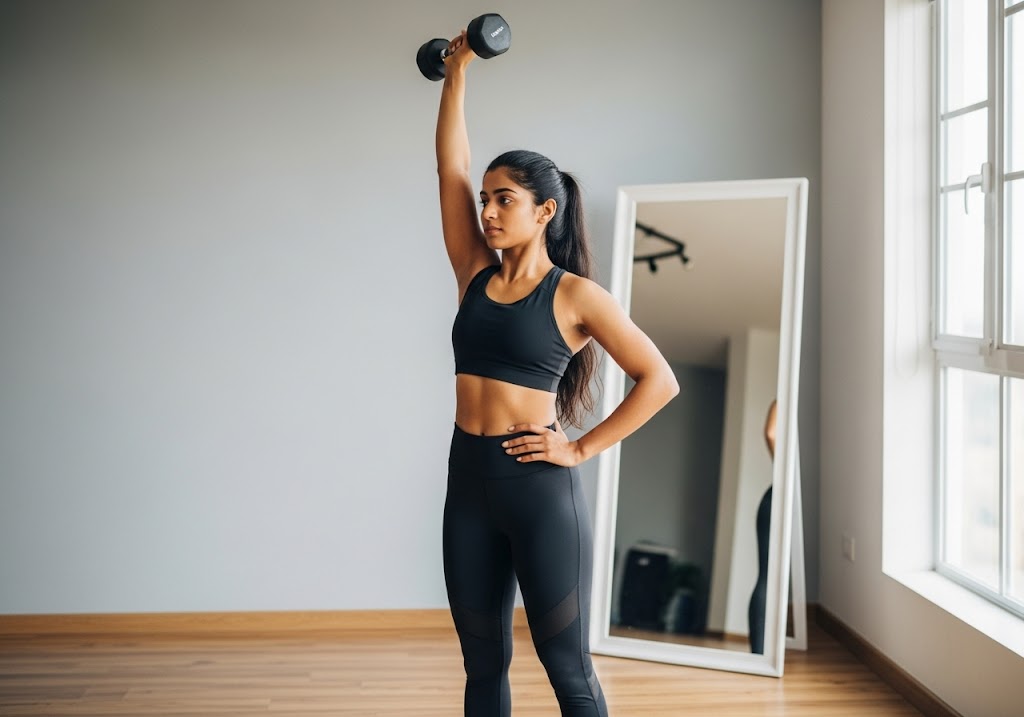
Advanced Training Methods for Full Body Calisthenics Workout
Advanced training methods elevate calisthenics beyond basic movements through sophisticated techniques like tempo manipulation, isometric holds, plyometric training, and unilateral progressions. These methods challenge experienced practitioners with skill-based movements, complex movement patterns, and specialized programming. Advanced techniques maximize strength gains, improve movement quality, and unlock elite-level bodyweight skills like handstands and muscle-ups.
1. Essential Movement Progressions
Essential movement progressions provide systematic pathways from beginner to advanced calisthenics skills. These structured sequences build strength, coordination, and technique gradually while preventing plateaus and injuries. Proper progressions ensure consistent advancement by breaking complex movements into manageable steps, allowing practitioners to master foundational patterns before attempting challenging variations and elite-level skills.
- Pull-up variations: Begin with assisted pull-ups and gradually progress to weighted versions as your strength improves. Experimenting with different grip positions—wide, neutral, or chin-up—helps develop complete upper-body pulling power.
- Push-up progressions: Move beyond standard push-ups by incorporating decline push-ups, one-arm push-ups, and planche push-ups. Each progression adds a new challenge, building on your previous strength gains to push upper body development further.
- Advanced squat variations: Start with bodyweight squats and progress to pistol squats, jump squats, and explosive single-leg variations. These exercises demand more balance, coordination, and lower-body control—essential for a complete calisthenics body.
2. Transformation Exercise Techniques for Full Body Calisthenics Workout
Transformation exercise techniques accelerate physical changes through strategic intensity manipulation, compound movement combinations, and metabolic conditioning. These powerful methods maximize muscle building, fat burning, and strength development simultaneously. By incorporating circuit training, supersets, time-under-tension variations, and progressive overload principles, these techniques create dramatic body composition improvements and functional fitness transformations.
- Muscle-up development: Break down this high-skill movement into components: begin with explosive pull-ups and straight bar dips. Once you’ve mastered each individually, combine them to achieve a clean muscle-up-a hallmark of advanced calisthenics workouts.
- Handstand push-ups: Start by training against a wall to build shoulder and core strength. As you gain control, reduce wall assistance to develop true vertical pushing strength and balance.
- Planche progressions: Build up gradually with planche leans, then move into tuck planches and eventually straddle holds. These steps help your body adapt to the intense demands of this elite-level calisthenics skill.
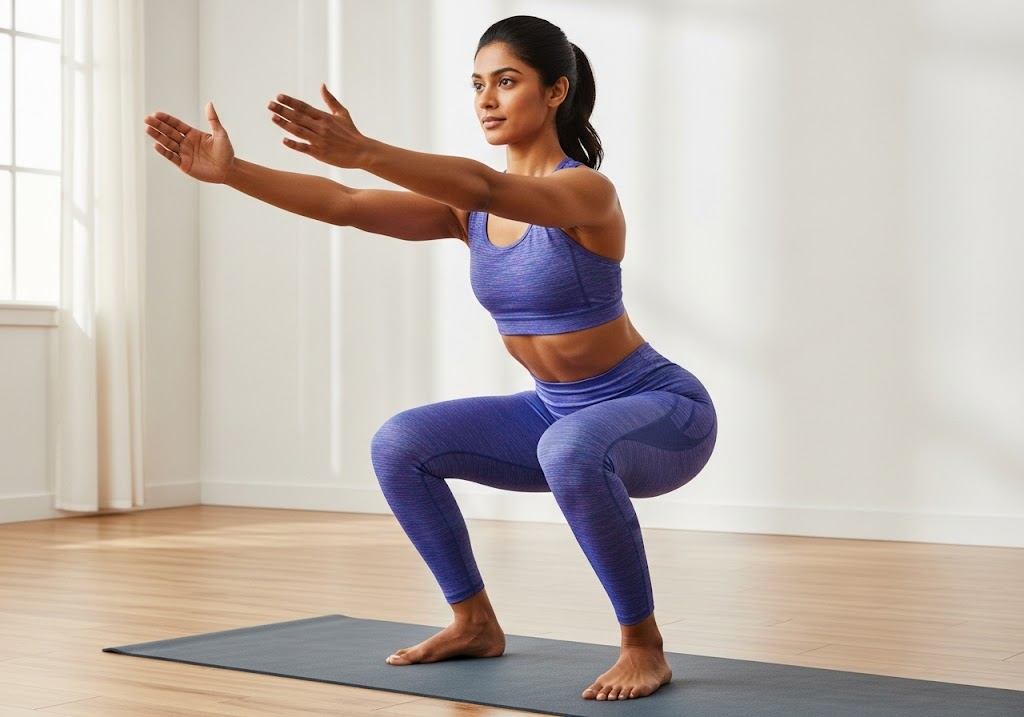
Structuring Your Training with the Best Calisthenics Exercises
Effective training structure maximizes results through strategic exercise selection, optimal workout sequencing, and progressive programming. Proper organization balances push-pull movements, incorporates adequate recovery, and follows logical progression patterns. Smart structuring prevents overtraining, ensures balanced development, and creates sustainable routines that build strength, endurance, and skill mastery through systematic calisthenics training approaches.
Workout Planning
Effective workout planning transforms random exercise into purposeful training through strategic goal setting, periodization, and systematic progression. Proper planning balances training frequency, intensity, and recovery while accommodating individual schedules and fitness levels. Smart planning prevents burnout, ensures consistent progress, and maximizes results by creating structured routines that adapt to your evolving strength and skill development.
- Set and repetition schemes: Design your calisthenics sessions around 3–4 sets of 8–12 reps for strength development. Adjust volume and intensity based on exercise difficulty and your current fitness level.
- Rest periods: Allow 60–90 seconds of rest between sets for adequate recovery. Shorter rest intervals can be used in endurance-focused workouts to maintain intensity.
- Progressive overload: Continually increase your workout difficulty by adding reps, reducing rest, or moving to harder variations. This principle is essential for ongoing strength and muscle gains in calisthenics.
Training Splits
Training splits strategically divide workouts across multiple days to optimize recovery, target specific muscle groups, and prevent overtraining. Whether using full-body, upper/lower, or push/pull/legs splits, proper division allows focused intensity while ensuring adequate rest. Smart splits maximize training frequency, promote muscle growth, and accommodate busy schedules through flexible, sustainable workout organization.
- Push day focus: Start with foundational pushing exercises and advance to movements like dips or handstand push-ups. Combine both horizontal (push-ups) and vertical (overhead pressing) patterns for full upper-body engagement.
- Pull day emphasis: Center your pull workouts around pull-ups, chin-ups, and bodyweight rows. Include scapular pulls and face pulls to strengthen shoulder stabilizers and avoid imbalances.
- Leg day structure: Incorporate squats, lunges, step-ups, and plyometrics to target all areas of the lower body. Blend strength-building and explosive exercises for well-rounded leg development.

Recovery and Progression
Effective calisthenics training goes beyond just pushing harder- it’s about smart recovery and steady progress. This section highlights key strategies to help your body recover and your skills evolve safely over time.
Recovery Strategies
- Active recovery: Incorporate light movement and mobility work between intense calisthenics body training sessions. This approach helps maintain flexibility while promoting recovery.
- Progressive loading: Gradually increase training volume and intensity over time as a part of good calisthenics workout. This measured approach helps prevent overtraining while ensuring consistent progress.
- Skill development: Focus on perfecting form in best calisthenics exercises before advancing to more challenging calisthenics body variations. Quality movement patterns form the foundation for advanced skills.
Long-term Development
- Consistent practice: Regular training sessions are essential for developing and maintaining strength. Schedule 3-4 weekly sessions for optimal progress in your calisthenics journey.
- Patient progression: Allow time for proper adaptation before advancing to more challenging movements. This methodical approach ensures safe and sustainable progress.
- Goal setting: Establish clear, progressive goals for your full body calisthenics workout routine. Track progress and adjust training plans based on your development.
Conclusion
A full body calisthenics workout program offers a sustainable, effective approach to fitness that can transform your body and enhance your physical capabilities. These transformation exercises not only help build strength but also improve flexibility and coordination. By following the principles and progressions outlined in this guide, you’ll be well-equipped to begin your calisthenics journey and achieve your fitness goals.
Ready to take your calisthenics journey to the next level with smarter recovery and sustainable progression? Whether you’re just starting or refining advanced movements, ISC – Indian School of Calisthenics is here to guide you every step of the way. Visit us at SRPF Ground, NH8, Goregaon (E), Mumbai – 400065. For class schedules, personalized coaching, or more details, call +91 77159 53218. Train smart, move better, and unlock your back strength with ISC.
Full Body Calisthenics Workout- FAQs
How often should I do a full body calisthenics workout?
Begin with 3-4 sessions per week, allowing adequate rest between workouts. As you advance, you can increase frequency while managing intensity.
Can I build muscle with calisthenics?
Yes, calisthenics can effectively build muscle through progressive overload and proper nutrition. Focus on challenging variations and adequate volume to maximize your full body calisthenics workout.
How long should a calisthenics workout last?
A typical session should last 45-60 minutes, including warm-up and cool-down. Quality of movement is more important than duration.
Do I need any equipment for calisthenics?
While many exercises require no equipment, a pull-up bar and parallel bars or rings can greatly expand your exercise options and enhance your full body calisthenics workout.
How long does it take to see results from calisthenics?
With consistent training and proper nutrition, you can expect to see initial strength gains within 4-6 weeks and visible physical changes within 8-12 weeks.
Can beginners start with calisthenics?
Yes, calisthenics is suitable for all fitness levels. Start with basic movements and progressively advance to more challenging variations, ensuring a good calisthenics workout for beginners.
Should I combine calisthenics with weight training?
While not necessary, combining calisthenics exercise with weight training can be effective for specific goals. Focus on mastering bodyweight movements first for a solid foundation in transformation exercises.
How important is diet in calisthenics training?
Proper nutrition is crucial for progress in calisthenics. Focus on adequate protein intake, balanced macronutrients, and proper hydration to support your full body calisthenics workout.
Can calisthenics help with fat loss?
Yes, calisthenics can aid fat loss by building muscle and increasing overall calorie burn, especially when combined with proper nutrition.
Is rest important between calisthenics workouts?
Absolutely. Rest allows your muscles to recover and grow, reducing the risk of injury and improving long-term performance.
What’s the best time of day to do calisthenics?
The best time is when you feel most energized—morning or evening. Consistency matters more than timing.
Can I train calisthenics every day?
Daily training is possible with smart planning—alternate muscle groups, include light sessions, and prioritize recovery.
